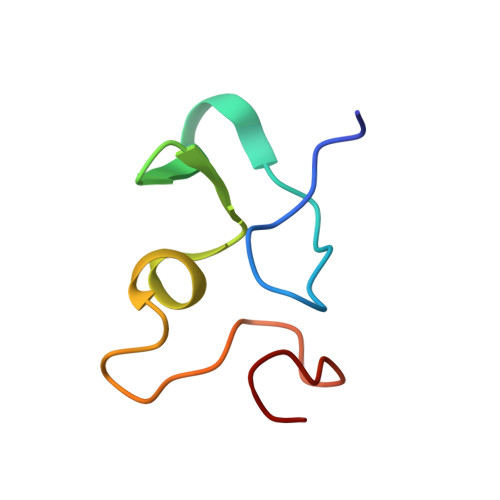A histidine-rich Pseudomonas metallothionein with a disordered tail displays higher binding capacity for cadmium than zinc.
Habjanic, J., Zerbe, O., Freisinger, E.(2018) Metallomics 10: 1415-1429
- PubMed: 30191219
- DOI: https://doi.org/10.1039/c8mt00193f
- Primary Citation of Related Structures:
6GRV, 6GV6, 6GV7, 6GW8 - PubMed Abstract:
Metallothioneins (MTs) are crucial players in metal-related physiological processes. They are characterized by a high cysteine content and unique metal binding properties resulting in specific metal-thiolate clusters formation. Here we present the first NMR solution structure of a Pseudomonas MT, PflQ2 MT, using the strain P. fluorescens Q2-87. It consists of a metal binding domain and an intrinsically disordered C-terminal tail, that was not observed in other MTs so far. While not influencing the structure or function of the metal binding domain, the tail contains a potential binding motif that might be important in so far undiscovered biological interactions. Unusual is the different metal binding capacity for three ZnIIversus four CdII ions that results in two novel metal-cluster topologies. Nevertheless, the affinity for the fourth CdII ion is reduced due to transient coordination. PflQ2 MT contains an unusually large number of four histidine residues, of which only one is involved in metal ion binding. The three non-coordinating histidine residues influence neither the protein fold nor the stability in vitro. We demonstrate that reinstatement of a second coordinating histidine residue, observed for cyanobacterial MTs, in place of a non-coordinating residue in Pseudomonas MTs, decreases the kinetic lability of the cluster, while preserving the overall metal ion binding stability and the protein fold. Since high thermodynamic stability combined with high kinetic lability of metal binding are mechanistic features critical for the function of MTs, the observed replacement might be advantageous for Pseudomonas MTs with respect to metal ion handling in vivo.
Organizational Affiliation:
Department of Chemistry, University of Zurich, Zurich, Switzerland. freisinger@chem.uzh.ch.















